55 Hypoallergenic Dog Breeds You Might Be Able To Live With If You Have Allergies

Hypoallergenic Dogs
Dogs are our best friends, but for people with pet allergies, sometimes being around them can be really rough. Between 15% and 30% of all Americans have a dog allergy, but that doesn’t mean they have to live dog-free lives. There are lots of strategies you can use to minimize the effects of these allergies. One strategy that some people use is to get a dog that’s hypoallergenic.
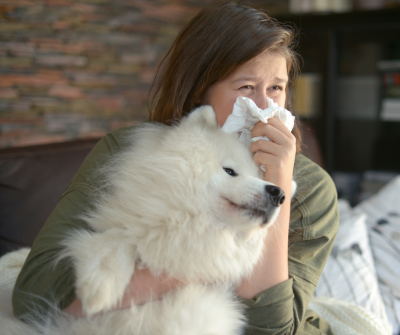
But is this always a good idea? While it is true that some dogs have qualities that make them less of a problem for people with allergies, “hypoallergenic” does not mean “free from allergens.” It means LESS allergens are present. It also doesn’t mean that all allergen types are reduced. There are multiple ways to be allergic to a dog!
A question I get ALL the time from the rescue community: Are pitbulls hypoallergenic? Keep scrolling to find out.
Where Do Dog Allergies Come From?
When you’re allergic to a dog, the symptoms can include things like watery eyes, an itchy, runny nose, sneezing, wheezing, and other hay fever-like symptoms. Some people even may develop a rash or hives. All of these symptoms come from our reaction to proteins that are produced by dogs. Some people are allergic to proteins in the saliva, the urine, or the dander of a dog.
Dander is the most common dog allergy trigger, or allergen. Dander is composed of tiny, even microscopic, flecks of skin shed by dogs and all animals with fur or feathers. These bits of skin can cause reactions in people who are specifically allergic to these triggers. Proteins found in dog saliva and waste can also cause allergic reactions. These allergens can easily become airborne due to the way that dogs shed.
According to the Asthma and Allergy Foundation of America, dog fur isn’t actually an allergen. Instead, the fur traps other allergens. When your dog sheds, these are left wherever they leave fur. This means that a dog that doesn’t shed will leave less of these allergens lying around.
What Makes A Dog Hypoallergenic?
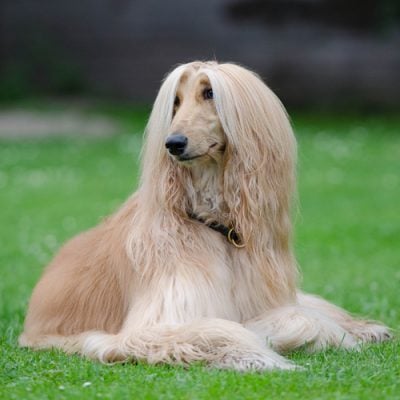
While all dogs produce dander, saliva, and other allergenic substances, some dogs have traits that make them less likely to release these into the atmosphere. These include dogs with hair coats, dogs with single coats, and dogs with curly coats.
Hair Versus Fur
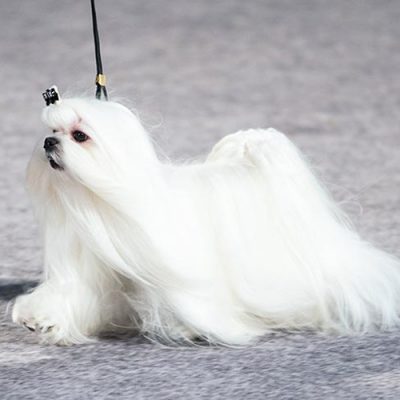
Dogs can produce either hair or fur, and the difference between the two means a lot for whether or not the it’s a hypoallergenic dog breed. Dog hair sheds less frequently than dog fur because dog hair doesn’t have a set length. Dog hair can grow and grow without shedding. Fur, on the other hand, has a set length. Once the fur reaches that length, it sheds out and takes those dander and saliva proteins with it.
Additionally, dogs with hair coats need more frequent grooming than dogs with fur coats to keep the hair from getting tangled. Even if you keep their hair fairly short, they still need brushed regularly, which can also help keep allergens low since brushing removes dead hair and dander.
Single Coats Versus Double Coats
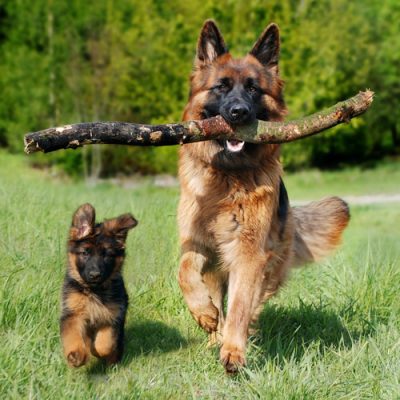
Some of the worst dogs for people with allergies are what we call double coated dogs. These dogs have a longer outer coat of fur or hair and a dense furry undercoat that keeps them warm and protected from the elements. These dogs include spitz breeds like huskies and Pomeranians, collie breeds like rough collies and border collies, retriever breeds like golden retrievers, Newfoundlands, and Labrador retrievers, and herding breeds like German shepherds and Australian shepherds.
If you or a family member has allergies, look for a dog with a single coat. These dogs shed less overall, and many have hair coats rather than fur.
Curly and Wire Haired Dogs
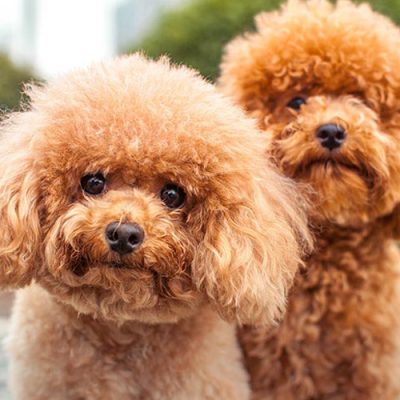
All dogs shed some hair from time to time, but dogs with certain coat textures shed a lot less than others. Dogs with curly coats and dogs with wiry or “broken” coats like many types of terriers have hair that forms a relatively tight coil. Some of these breeds, like poodles, have a single coat of curly hair. When they shed, the shed hairs often fall back into the coat instead of on your furniture. Wirehaired dogs have a double coat and they do have an annual shed when their denser winter coat falls out. If you take your wirehaired dog to a groomer, however, they can use various tools to get the whole coat out at once, returning your dog to its less-allergenic state.
What About Hairless Dogs?
Many people think that hairless dogs are truly non-allergenic, because they don’t shed. But this is not the case at all! Hairless dogs still have saliva that people can be allergic to, and they still produce dander. Dander from hairless dogs doesn’t get trapped in their coat (because they don’t have one), and because they are hairless, the dander is easier to remove by bathing. And because hairless dogs need regular skincare, you’ll be keeping them nice and clean– and therefore less allergenic!
55 Hypoallergenic Dog Breeds
With all of that information in mind, here is a list of hypoallergenic dogs and why they’re considered hypoallergenic.
| Breed | Hypoallergenic Qualities |
| Airedale Terrier | Wire coat, low shedding |
| Affenpinscher | Wire coat, retains dander |
| Afghan Hound | Hair coat, single coat |
| Australian Terrier | Wire coat, low shedding |
| Aussiedoodle | low-shedding and hypoallergenic coats |
| Australian Labradoodle | Low shedding |
| American Hairless Terrier | Hairless |
| Barbet | Curly hair coat, low shedding |
| Bedlington Terrier | Curly hair coat, low shedding |
| Bergamasco | Rough hair coat that forms locks that keep dander low |
| Bichon Frise | Hair coat, single coat, low shedding |
| Biewer Terrier | Hair coat |
| Bolognese | Hair coat |
| Border Terrier | Wire coat, retains dander, low shedding |
| Bouvier des Flandres | Wire coat, low shedding |
| Brussels Griffon | Wire coat, low shedding |
| Cairn Terrier | Wire coat, low shedding |
| Cesky Terrier | Wire coat, low shedding |
| Chinese Crested | Hairless or hair coat (“Powderpuff” variety) |
| Coton de Tulear | Hair coat, single coat, low shedding |
| Dandie Dinmont Terrier | Wire coat, retains dander, low shedding |
| German Wirehaired Pointer | Wire coat, low shedding |
| Havanese | Hair coat |
| Irish Terrier | Wire coat, retains dander, low shedding |
| Irish Water Spaniel | Curly coat (Note: this breed is double-coated but the water-repellent outer coat keeps the dander on the dog and not in the air) |
| Italian Greyhound | Very low shedding (Note: Italian greyhounds only; the other greyhound breed and greyhound mixes do shed frequently) |
| Kerry Blue Terrier | Wire coat, low shedding |
| Lagotto Romagnolo | Curly coat, hair coat, low shedding |
| Lakeland Terrier | Wire coat, low shedding |
| Lowchen | Hair coat, low shedding |
| Maltese | Hair coat, low shedding. One of the best hypoallergenic dogs for kids |
| Norfolk Terrier | Wire coat, low shedding |
| Norwich Terrier | Wire coat, low shedding |
| Peruvian Inca Orchid | Hairless |
| Poodle (all 3 breeds: Standard, Miniature, and Toy) | Curly coat, hair coat, retains dander, low shedding |
| Portuguese Water Dog | Curly coat (Note: this breed is double-coated but the water-repellent outer coat keeps the dander on the dog and not in the air) |
| Puli | Curly hair coat that forms tight “locks” that keep dander under control |
| Russkaya Tsvetnaya Bolonka (Russian Colored Lapdog) | Hair coat |
| Samoyed | Naturally low dander level; however, this breed does shed a lot, so if your allergy is to dog saliva and not dander, this breed is not recommended! |
| Schnauzer (all 3 breeds: Giant, Standard, and Miniature) | Wire coat, low shedding |
| Scottish Terrier | Wire coat, low shedding |
| Sealyham Terrier | Wire coat, low shedding |
| Shih Tzu | Hair coat, single coat, low shedding |
| Silky Terrier | Hair coat, low shedding |
| Soft-coated Wheaten Terrier | Hair coat, single coat, low shedding |
| Spanish Water Dog | Water repellent curly coat, single coat |
| Tibetan Terrier | Wire coat, low shedding |
| Welsh Terrier | Wire coat, low shedding |
| West Highland White Terrier | Wire coat, low shedding |
| Wire Fox Terrier | Wire coat, low shedding (Note: the other fox terriers– the Smooth Fox and the Toy Fox– are not hypoallergenic) |
| Wirehaired Pointing Griffon | Wire coat, low shedding |
| Xoloitzcuintli | Hairless |
| Yorkshire Terrier | Hair coat |
Are pitbulls hypoallergenic?
Unfortunately Pitbulls did not make our list of hypoallergenic dogs. But cheer up, they aren’t the worst dog to have if you have allergies. But they do shed twice a year. When this happens dander spreads and that’s no bueno for you. They also slobber and lick quite a bit and saliva is definitely an allergen for many allergic people.
What About Crossbreeds?
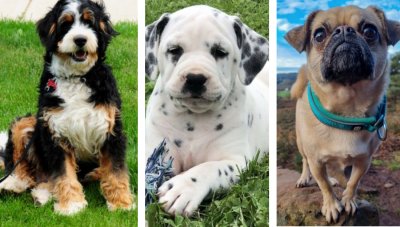
I know what you’re thinking. Where are the doodles?
In recent years, designer dogs, including poodle mixes like goldendoodles, labradoodles, and maltipoos have become increasingly popular. Many are claimed to be hypoallergenic. The same is true for some other mixes where one of the parent breeds is hypoallergenic.
While these dogs are great, loving, and loyal family dogs, genetics aren’t guaranteed in a crossbreed. And a lot of these doodle breeds are crosses where one half is poodle– a hypoallergenic breed– but the other half is from a breed that sheds. Not all doodles have the same coat type; in fact, not even all doodles from the same litter will have the same coat type! So to be on the safe side, these dogs can’t be considered truly hypoallergenic as a whole.
Where To Adopt A Hypoallergenic Dog
If you want to adopt a hypoallergenic dog, the good news is that you can find them in shelters and rescues. The key to bringing one of these dogs into your home is patience and communication. Talk with the shelter or rescue staff about what kinds of qualities you’re looking for in a dog, and ask them if you can be on a wait list or notified when a dog with hypoallergenic traits comes into the rescue.
These rescue organizations usually use foster homes, and while not every dog they take in is a purebred, the fosters will be knowledgeable about the dog’s shedding tendencies and other allergen factors.
The best way to tell if you’ll be allergic to a rescue dog is to visit them. If you can meet with the dog outside or at a foster home instead of a shelter, you have a better chance of being able to interact with that particular dog’s allergens (as opposed to the allergens of other dogs floating in the air). Spending fifteen minutes or so with a dog will be long enough to trigger your body’s reaction.
Ultimately, there’s no such thing as a truly no-allergen dog. But dogs with the traits discussed above do produce fewer allergic reactions, making it easier to bring them into your family.




